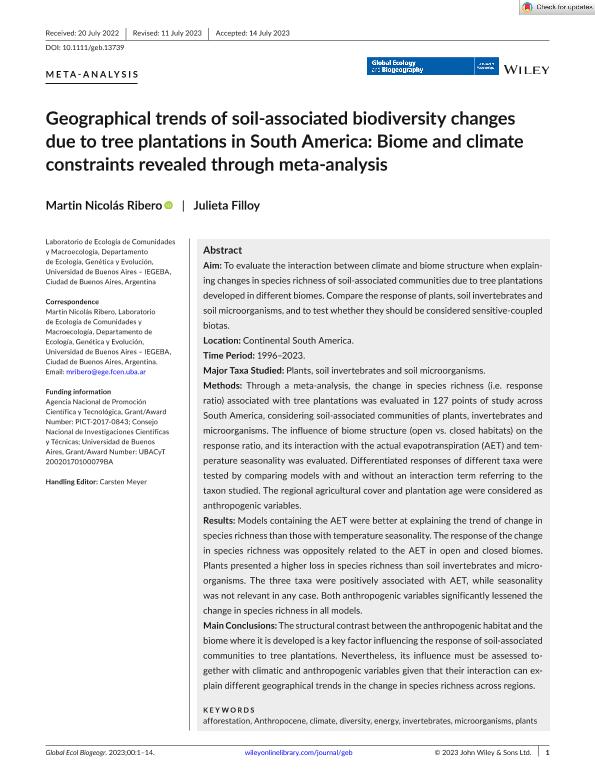Mostrar el registro sencillo del ítem
dc.contributor.author
Ribero, Martin Nicolas

dc.contributor.author
Filloy, Julieta

dc.date.available
2024-01-09T11:22:55Z
dc.date.issued
2023-07
dc.identifier.citation
Ribero, Martin Nicolas; Filloy, Julieta; Geographical trends of soil‐associated biodiversity changes due to tree plantations in South America: Biome and climate constraints revealed through meta‐analysis; Wiley Blackwell Publishing, Inc; Global Ecology and Biogeography; 7-2023; 1-14
dc.identifier.issn
1466-822X
dc.identifier.uri
http://hdl.handle.net/11336/222935
dc.description.abstract
AimTo evaluate the interaction between climate and biome structure when explaining changes in species richness of soil-associated communities due to tree plantations developed in different biomes. Compare the response of plants, soil invertebrates and soil microorganisms, and to test whether they should be considered sensitive-coupled biotas.LocationContinental South America.Time Period1996–2023.Major Taxa StudiedPlants, soil invertebrates and soil microorganisms.MethodsThrough a meta-analysis, the change in species richness (i.e. response ratio) associated with tree plantations was evaluated in 127 points of study across South America, considering soil-associated communities of plants, invertebrates and microorganisms. The influence of biome structure (open vs. closed habitats) on the response ratio, and its interaction with the actual evapotranspiration (AET) and temperature seasonality was evaluated. Differentiated responses of different taxa were tested by comparing models with and without an interaction term referring to the taxon studied. The regional agricultural cover and plantation age were considered as anthropogenic variables.ResultsModels containing the AET were better at explaining the trend of change in species richness than those with temperature seasonality. The response of the change in species richness was oppositely related to the AET in open and closed biomes. Plants presented a higher loss in species richness than soil invertebrates and microorganisms. The three taxa were positively associated with AET, while seasonality was not relevant in any case. Both anthropogenic variables significantly lessened the change in species richness in all models.Main ConclusionsThe structural contrast between the anthropogenic habitat and the biome where it is developed is a key factor influencing the response of soil-associated communities to tree plantations. Nevertheless, its influence must be assessed together with climatic and anthropogenic variables given that their interaction can explain different geographical trends in the change in species richness across regions.
dc.format
application/pdf
dc.language.iso
eng
dc.publisher
Wiley Blackwell Publishing, Inc

dc.rights
info:eu-repo/semantics/openAccess
dc.rights.uri
https://creativecommons.org/licenses/by-nc-sa/2.5/ar/
dc.subject
AFFORESTATION
dc.subject
ANTHROPOCENE
dc.subject
CLIMATE
dc.subject
DIVERSITY
dc.subject
ENERGY
dc.subject
INVERTEBRATES
dc.subject
MICROORGANISMS
dc.subject
PLANTS
dc.subject.classification
Ecología

dc.subject.classification
Ciencias Biológicas

dc.subject.classification
CIENCIAS NATURALES Y EXACTAS

dc.title
Geographical trends of soil‐associated biodiversity changes due to tree plantations in South America: Biome and climate constraints revealed through meta‐analysis
dc.type
info:eu-repo/semantics/article
dc.type
info:ar-repo/semantics/artículo
dc.type
info:eu-repo/semantics/publishedVersion
dc.date.updated
2024-01-09T10:46:15Z
dc.journal.pagination
1-14
dc.journal.pais
Reino Unido

dc.description.fil
Fil: Ribero, Martin Nicolas. Universidad de Buenos Aires. Facultad de Ciencias Exactas y Naturales. Departamento de Ecología, Genética y Evolución. Ecología de Comunidades y Macroecología; Argentina. Consejo Nacional de Investigaciones Científicas y Técnicas. Oficina de Coordinación Administrativa Ciudad Universitaria. Instituto de Ecología, Genética y Evolución de Buenos Aires. Universidad de Buenos Aires. Facultad de Ciencias Exactas y Naturales. Instituto de Ecología, Genética y Evolución de Buenos Aires; Argentina
dc.description.fil
Fil: Filloy, Julieta. Consejo Nacional de Investigaciones Científicas y Técnicas. Oficina de Coordinación Administrativa Ciudad Universitaria. Instituto de Ecología, Genética y Evolución de Buenos Aires. Universidad de Buenos Aires. Facultad de Ciencias Exactas y Naturales. Instituto de Ecología, Genética y Evolución de Buenos Aires; Argentina. Universidad de Buenos Aires. Facultad de Ciencias Exactas y Naturales. Departamento de Ecología, Genética y Evolución. Ecología de Comunidades y Macroecología; Argentina
dc.journal.title
Global Ecology and Biogeography

dc.relation.alternativeid
info:eu-repo/semantics/altIdentifier/url/https://onlinelibrary.wiley.com/doi/10.1111/geb.13739
dc.relation.alternativeid
info:eu-repo/semantics/altIdentifier/doi/http://dx.doi.org/10.1111/geb.13739
Archivos asociados
